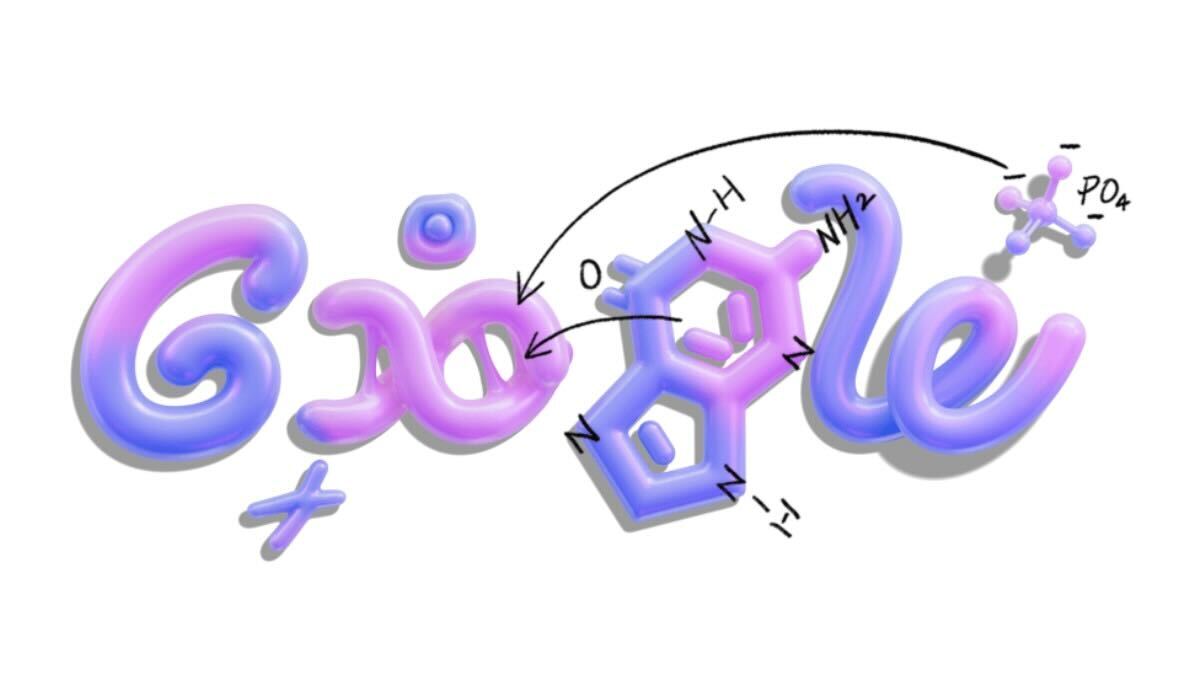Science
Google Doodle Celebrates DNA Discovery and Its Journey

Today’s Google Doodle for the Indian region highlights the significance of DNA (Deoxyribonucleic Acid), reflecting the peak in public interest around this topic during this time of year. This illustration first appeared for users in the United States on September 10, followed by the United Kingdom on September 18, and later for users in Europe, the Middle East, and Africa on October 23.
Understanding DNA’s Origins
The acronym DNA has become commonplace in various contexts, but its formal discovery traces back to the late 1860s. A common misconception is that the structure of DNA was first identified by James Watson and Francis Crick in the early 1950s. In reality, foundational work had commenced a century earlier. In 1869, Johann Friedrich Miescher, a Swiss chemist, identified a substance he called “nuclein” while researching white blood cells from pus-coated bandages at a local clinic. His isolation of nuclein from the cell nuclei was groundbreaking, achieved even without the aid of modern centrifuges, which were not developed until the early 20th century.
Miescher’s technique was a rudimentary form of centrifugation, paving the way for future advancements such as the continuous centrifugal separator invented by Gustaf de Laval in 1879. While it is inaccurate to claim that DNA was discovered without any technology, the methods employed by scientists of Miescher’s era were primitive compared to today’s standards.
Key Milestones in DNA Research
In 1919, Phoebus Levene, a biochemist at the Rockefeller Institute, identified the four bases of DNA, which consist of sugar and phosphate chains. He referred to these building blocks as “nucleotides.” Then, in 1927, Russian biologist Nikolai Koltsov proposed that DNA molecules are composed of two mirror strands that replicate in a semi-conservative manner, asserting that DNA serves as a “giant hereditary molecule.”
The timeline continues to 1952, when critical advancements were made in understanding DNA’s structure. In 1937, physicist William Thomas Astbury obtained the first X-ray diffraction patterns of DNA, and in 1948, Linus Pauling discovered that certain proteins exhibit a helical structure. The pivotal moment arrived when Rosalind Franklin, under the supervision of Raymond Gosling, captured the famous Photo 51—a vital X-ray diffraction image of DNA. This image played a crucial role in shaping the models proposed by Watson and Crick.
In 1953, Watson and Crick published their landmark paper titled “Molecular Structure of Nucleic Acids: A Structure for Deoxyribose Nucleic Acid,” presenting their model of DNA’s double-helix structure. Regrettably, Franklin’s significant contributions were largely overlooked for many years, overshadowing her critical role in this scientific breakthrough.
The legacy of DNA research continues to influence numerous fields, from genetics to biotechnology, highlighting the impact of early discoveries on contemporary science. The Google Doodle serves as a reminder of the journey that DNA has undertaken from its initial discovery to its current status as a cornerstone of biological research.
-

 World5 months ago
World5 months agoSBI Announces QIP Floor Price at ₹811.05 Per Share
-

 Lifestyle5 months ago
Lifestyle5 months agoCept Unveils ₹3.1 Crore Urban Mobility Plan for Sustainable Growth
-

 Science4 months ago
Science4 months agoNew Blood Group Discovered in South Indian Woman at Rotary Centre
-

 World5 months ago
World5 months agoTorrential Rains Cause Flash Flooding in New York and New Jersey
-

 Top Stories5 months ago
Top Stories5 months agoKonkani Cultural Organisation to Host Pearl Jubilee in Abu Dhabi
-

 Sports4 months ago
Sports4 months agoBroad Advocates for Bowling Change Ahead of Final Test Against India
-

 Science5 months ago
Science5 months agoNothing Headphone 1 Review: A Bold Contender in Audio Design
-

 Top Stories5 months ago
Top Stories5 months agoAir India Crash Investigation Highlights Boeing Fuel Switch Concerns
-

 Business5 months ago
Business5 months agoIndian Stock Market Rebounds: Sensex and Nifty Rise After Four-Day Decline
-

 Sports4 months ago
Sports4 months agoCristian Totti Retires at 19: Pressure of Fame Takes Toll
-

 Politics5 months ago
Politics5 months agoAbandoned Doberman Finds New Home After Journey to Prague
-

 Top Stories5 months ago
Top Stories5 months agoPatna Bank Manager Abhishek Varun Found Dead in Well









